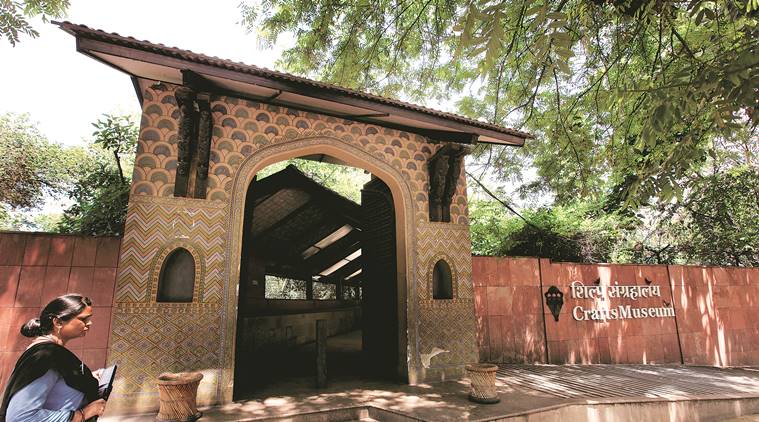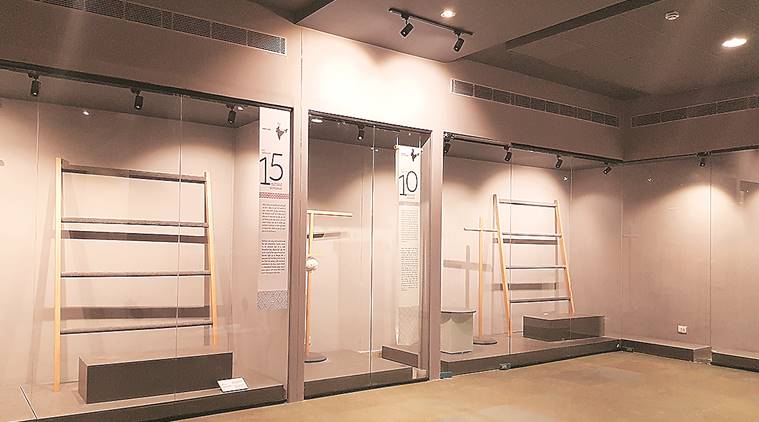
While most remember Kamaladevi Chattopadhyay for her role in the freedom movement and her work for the betterment of the socio-economic conditions of women, the Mangaluru-born firebrand activist was also the driving force behind the renaissance of Indian handicrafts and handloom post 1947. It was owing to her belief in the artistic heritage of India that the Crafts Museum was set up in the heart of India’s capital in 1958.
After it came into existence, it took over two decades for the space to evolve into its present form, acquiring pieces of handloom and handicraft from all over India, with a view of make these crafts financially viable and help the artisans. The five-acre premises now holds 35,000 distinctive pieces, reflecting India’s craft traditions through painting, embroidery, textiles, clay, stone and wood, housed in the building designed by noted architect Charles Correa in the ’70s. The museum also houses a village complex, where several traditional craftsmen-in-residence can be seen working in a designated area, also selling their wares.

While the galleries dedicated to paintings, clay, stone and wood are housed on the ground floor, around the same courtyard, it was the all-important textiles gallery which had been vying for attention lately. The air-conditioning system was dysfunctional, the display style outdated, and the first-floor gallery offered no ease of access to visitors. Consequently, there was a decline in footfall.
“The Ministry (of textiles, which runs the museum) took note almost a year ago and decided to build a new modern textiles gallery on the ground floor itself, adjacent to other galleries,” says Raghvendra Singh, Secretary, Ministry of Textiles, adding that the priceless collection would have also gotten affected as the faulty air-conditioning system was beyond repair. Currently, final touches are being given to the space and the new gallery is due to open in less than a month’s time.
The plan is also afoot to make the gallery into a resource centre for students and scholars alike, offering information about the history of Indian textiles. Author and former bureaucrat Sujata Prasad, an advisor with the Ministry, who is part of the committee overseeing the Rs 1-crore project, says, “To enhance visitor experience, focussed exhibitions on specific themes, regions, periods and traditions will complement the permanent gallery.”
While the earlier display misses out on important aspects of the history of the display, the new display is also being designed in a way that the notes tagged alongwith are interesting, crisp and useful. Prasad, who was earlier part of the Ministry’s Handloom Haat project at Janpath, is currently in the process of finalising the accompanying text.
Sohan Kumar Jha, Senior Director at the museum, explains that since the new space is smaller, the display will be kept dynamic. “While half of the around 400 items will be put on display, the rest will be kept in the reserve collection. But the display won’t be static and is likely to change from time to time,” he says.

Some of its prized collection include, the 250-300-year-old, Bhoota Collection from Karnataka, rare Kashmiri 300-year-old ‘dushalas’, handkerchiefs from Chamba, known for their unique embroidery, rare brocade and Baluchari saris, mundu and veshti, cotton fabrics from Kerala, phulkari dupattas from Punjab and Chanderis from Madhya Pradesh. The last piece acquired for the collection was in 2003.
The new display will be divided into five zones such as weaving (from various states), embroidery (chikankari, kantha, phulkari), dying (ikat and patola), patterns (bandhani, kalamkari, leheriya) and tana-bana, based on the complexity of the textile. “Instead of bland showcase displays, there will be a novelty in mounting the garment using ladders, hangers and stands,” says Jha, adding that there will also be a tactile map of India, detailing the history of the country’s handwoven and handspun traditions, besides mannequins to display robes and special garments.
Meanwhile, the courses under the aegis of the Hastakala Academy will also start from the premises this summer. A few years ago, the government had announced in the Union Budget that it was setting up a Hastakala Academy in Delhi “for the preservation, revival and documentation of the handloom/ handicraft sector”. Singh says “the academy aims to nurture and support handloom and handicraft traditions within an academic and research space for connoisseurs, students, researchers, scenographers and designers”. Six courses have been listed for this year — puppetry, terracotta, Gond and Madhubani paintings, bamboo craft, weaving and block-printing.